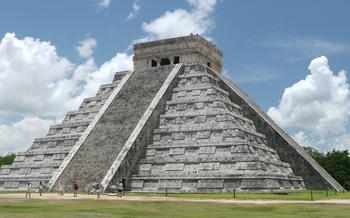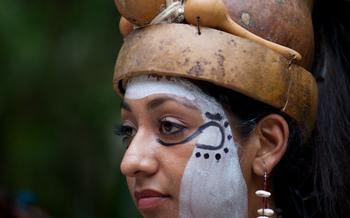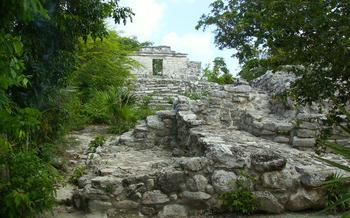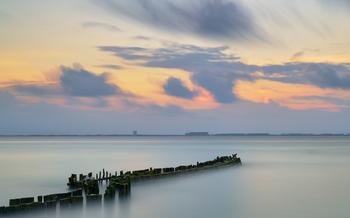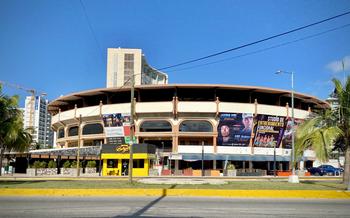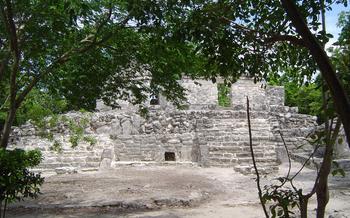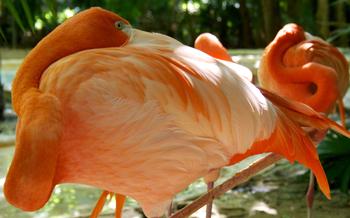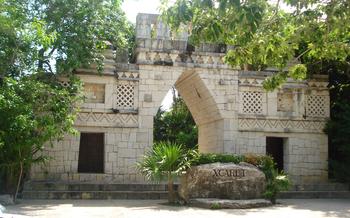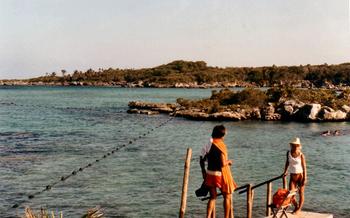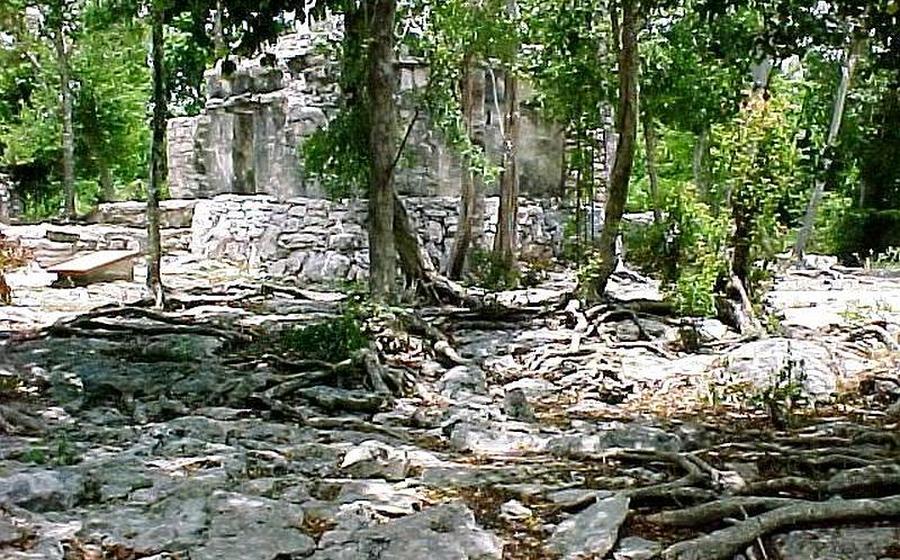
Cancun Underwater Museum (MUSA)
- History of the Cancun Underwater Museum (MUSA)
- The Underwater Sculptures
- Snorkeling and Diving at MUSA
- MUSA's Conservation Efforts
- Tips for Visiting MUSA
- The El Niño Sculpture
- The Ocean Atlas Sculpture
- The Silent Evolution Sculpture
- The Dream Gate Sculpture
- The Man on Fire Sculpture
- The Coral Restoration Program
- Educational Outreach Programs
- How Visitors Can Support MUSA
- Nearby Attractions
- Insider Tip
History of the Cancun Underwater Museum (MUSA)
In 2009, a group of marine conservationists, artists, and government officials came together to create the Cancun Underwater Museum (MUSA). The museum was founded with the goal of protecting the Mesoamerican Reef, the second-largest coral reef system in the world, and to create a unique and immersive experience for visitors.
The artists involved in creating the sculptures for MUSA were all world-renowned for their work in underwater sculpture. The most famous artist involved was Jason deCaires Taylor, a British sculptor who has created underwater sculptures all over the world.
The sculptures in MUSA are made from a variety of materials, including cement, fiberglass, and PVC. The materials were chosen for their durability and their ability to mimic the natural textures of the reef.
The sculptures are all designed to interact with the marine environment. The sculptures provide a habitat for marine life, and they also help to slow down the erosion of the reef.
The Underwater Sculptures
The underwater sculptures at MUSA are a diverse collection of over 500 individual pieces, each with its own unique design and meaning. The sculptures are made from a variety of materials, including concrete, fiberglass, and ceramic. Some of the sculptures are life-size, while others are much larger. The sculptures are arranged in several different galleries, each with its own theme.
The most popular gallery is the Nizuc Gallery, which features a collection of sculptures that are inspired by the Mayan culture. The sculptures in this gallery include a giant head of a Mayan king, a group of Mayan musicians, and a replica of a Mayan temple.
Another popular gallery is the Manchones Gallery, which features a collection of sculptures that are inspired by the natural world. The sculptures in this gallery include a giant sea turtle, a group of dolphins, and a coral reef.
The sculptures at MUSA are not just works of art; they also serve an important purpose. The sculptures help to create a habitat for marine life. The sculptures provide a place for fish to hide from predators, and they also help to attract new fish to the area. The sculptures also help to protect the coral reef from damage. The sculptures act as a barrier between the reef and the waves, and they also help to reduce erosion.
Snorkeling and Diving at MUSA
The best time of day to visit the Cancun Underwater Museum (MUSA) for snorkeling and diving is in the morning, when the water is calm and clear. There are several different tour options available, ranging from guided snorkeling tours to scuba diving excursions. On a typical snorkeling tour, visitors will be provided with a mask, snorkel, and fins, and will be led by a guide who will point out the different sculptures and explain their significance. Scuba diving tours are also available, and these allow visitors to explore the museum's deeper waters and see the sculptures from a different perspective.
The underwater sculptures at MUSA are home to a variety of marine life, including tropical fish, sea turtles, and rays. Visitors can expect to see a variety of colorful coral formations as well. The museum is also a popular spot for underwater photography, and visitors are encouraged to bring their own cameras to capture the unique beauty of the sculptures and the surrounding marine environment.
It is important to note that there are a few safety precautions that visitors should take when snorkeling or diving at MUSA. First, all visitors must wear a life jacket. Second, it is important to stay hydrated by drinking plenty of water before and after your dive. Third, visitors should avoid touching the sculptures, as this can damage them. Finally, it is important to be aware of your surroundings and to stay close to your guide.
MUSA's Conservation Efforts
MUSA is not just an art gallery but also a marine conservation organization. The museum helps to protect the Mesoamerican Reef, the second-largest coral reef in the world, through several initiatives.
One of these initiatives is the museum's coral restoration program. The program aims to restore damaged coral reefs and create new ones using artificial reefs. The museum has planted over 40,000 corals since the program began in 2009, and it continues to plant more each year.
MUSA also has several educational outreach programs designed to raise awareness about marine conservation. The museum offers guided tours of the museum, educational workshops, and presentations. The museum also works with local schools to teach students about the importance of marine conservation.
Visitors to MUSA can support the museum's conservation efforts by donating to the museum, volunteering their time, or spreading the word about the museum. Visitors can also support the museum by purchasing tickets to the museum. The money from ticket sales helps to fund the museum's conservation efforts.
Tips for Visiting MUSA
Planning a trip to the Cancun Underwater Museum (MUSA) can be an exciting adventure, but to make the most of your experience, it's important to come prepared. Here are some tips to ensure a smooth and enjoyable visit:
-
Book your tour in advance: MUSA is a popular destination, and tours can fill up quickly, especially during peak season. Booking your tour in advance will guarantee your spot and ensure that you don't miss out on this unique experience.
-
Bring the essentials: When packing for your snorkeling or diving trip, don't forget to bring a swimsuit, towel, sunscreen, and sunglasses. You may also want to consider bringing a waterproof camera to capture your underwater memories.
-
Wear comfortable clothing: For snorkeling or diving, it's best to wear comfortable and lightweight clothing that you can move around in easily. Avoid wearing anything that is too baggy or restrictive.
-
Stay hydrated and protected from the sun: The sun can be intense in Mexico, so it's important to stay hydrated and protected from sunburn. Drink plenty of water throughout the day and reapply sunscreen regularly.
The El Niño Sculpture
The El Niño sculpture, created by artist Jason deCaires Taylor, is one of the most iconic and recognizable pieces in MUSA. The sculpture depicts a young boy sitting on a rock, with his head bowed and his hands clasped together. The boy's expression is one of contemplation and sorrow, and the sculpture seems to capture the essence of childhood innocence and vulnerability.
The El Niño sculpture has been interpreted in many different ways. Some see it as a symbol of the impact of climate change on the environment, while others see it as a representation of the plight of refugees and migrants. The sculpture has also been seen as a symbol of hope, as it suggests that even in the darkest of times, there is always light at the end of the tunnel.
The El Niño sculpture is located in the Manchones reef, which is one of the most popular snorkeling and diving sites in MUSA. The sculpture is situated in a shallow area, making it easy to see from the surface. Visitors can also swim down to the sculpture and see it up close.
The Ocean Atlas Sculpture
The Ocean Atlas sculpture is one of the most iconic and recognizable sculptures in MUSA. It is a massive concrete sculpture of a man carrying the world on his shoulders. The sculpture was created by Jason deCaires Taylor, a British sculptor who is known for his underwater sculptures.
The Ocean Atlas sculpture is a symbol of the burden that we are placing on the oceans. The sculpture is a reminder that we need to take care of our oceans and protect them from pollution and overfishing. The sculpture is also a symbol of hope and resilience. It shows that even though we are facing many challenges, we can still overcome them and create a better future for our planet.
The Ocean Atlas sculpture is located in the Manchones Reef, which is about 3 miles (5 kilometers) from the coast of Cancun. The sculpture is 30 feet (9 meters) tall and weighs 40 tons. It is the largest underwater sculpture in the world.
The Ocean Atlas sculpture is a must-see for anyone who is visiting MUSA. It is a powerful and moving sculpture that will stay with you long after you leave the museum.
The Silent Evolution Sculpture
The Silent Evolution sculpture by Jason deCaires Taylor is a poignant and thought-provoking piece that speaks to the impact of climate change and pollution on the world's oceans. The sculpture depicts a group of children, each with a different facial expression, symbolizing the diversity of humanity and the shared vulnerability to environmental degradation. The children are depicted with snorkel masks over their mouths, a powerful symbol of the silence and inaction that has allowed the destruction of the marine environment to continue unabated.
The artist created the sculpture using a combination of cement and fiberglass, materials that are both durable and non-toxic to marine life. The sculpture's placement on the seafloor allows it to interact with the surrounding environment, becoming a haven for coral and other marine organisms. Over time, the sculpture will evolve as the coral grows and changes, creating a living and dynamic work of art.
The Silent Evolution has been interpreted in many different ways by viewers, some seeing it as a call to action to protect the oceans, while others view it as a symbol of hope and resilience. Regardless of one's interpretation, the sculpture is a powerful and moving reminder of the importance of protecting the world's oceans and preserving them for future generations.
Visitors to MUSA can find the Silent Evolution sculpture in the Manchones Reef area, where it stands as a silent sentinel, urging us to confront the challenges facing our planet and to work together to create a more sustainable future.
The Dream Gate Sculpture
The Dream Gate sculpture, created by artist Jason deCaires Taylor, is a captivating masterpiece that invites visitors to contemplate the interconnectedness of humanity. Inspired by the ancient Mayan belief that dreams are a portal to other realms, the sculpture features a series of ethereal figures emerging from a circular gate, symbolizing the transition between the conscious and subconscious worlds.
Constructed using a combination of concrete, steel, and recycled materials, the Dream Gate is a testament to Taylor's commitment to sustainable art. The materials used in its creation not only contribute to its durability but also provide a habitat for marine life, fostering a harmonious coexistence between art and nature.
The Dream Gate has become a popular photo spot for visitors to MUSA, who are drawn to its enigmatic beauty and symbolic significance. Its placement within the underwater landscape creates a surreal and immersive experience, allowing visitors to feel as though they are stepping into a realm of dreams and imagination.
The Man on Fire Sculpture
The story behind the sculpture
The sculpture depicts a man engulfed in flames, symbolizing the destruction caused by human activity on the environment. The sculpture was created by artist Jason deCaires Taylor in 2013 and is part of the Silent Evolution series.
The significance of the sculpture
The Man on Fire sculpture is a powerful reminder of the devastating impact that humans are having on the planet. The sculpture serves as a warning that we need to change our ways and start living in harmony with nature.
How the sculpture has become a symbol of resilience
Despite the somber message that the sculpture conveys, it has also become a symbol of hope and resilience. The sculpture shows that even in the darkest of times, there is always hope for redemption.
Where to find the sculpture in the museum
The Man on Fire sculpture is located in the Punta Nizuc section of the museum, which is accessible by boat from the mainland.
The Coral Restoration Program
The Cancun Underwater Museum (MUSA) is actively involved in a coral restoration program, aimed at helping to restore the damaged coral reefs in the area. The program involves collecting fragments of broken or damaged coral and attaching them to specially designed frames. The frames are then placed in the ocean, where the coral fragments can grow and reproduce.
The program has been successful in restoring several different types of corals, including staghorn coral, elkhorn coral, and brain coral. These corals are important for the health of the reef ecosystem, as they provide food and shelter for a variety of marine life. The program also helps to protect the coastline from erosion and storm damage.
Visitors to MUSA can learn more about the coral restoration program and how they can help to support it. The museum offers a variety of educational programs and tours, which provide information about the importance of coral reefs and the threats they face. Visitors can also donate to the program or volunteer their time to help with the restoration work.
Educational Outreach Programs
The Cancun Underwater Museum (MUSA) is committed to educating the public about the importance of marine conservation. To this end, the museum offers a variety of educational outreach programs, including guided tours, lectures, and workshops.
The guided tours are led by experienced marine biologists who provide visitors with information about the museum's sculptures, the marine environment, and the importance of protecting both. The lectures and workshops cover a variety of topics, such as coral reef ecology, marine pollution, and climate change.
The museum's educational outreach programs are designed to help visitors of all ages understand the importance of marine conservation and to inspire them to take action to protect the ocean. The programs are also a great way to learn more about the Cancun Underwater Museum and its unique collection of sculptures.
Visitors can participate in the programs by contacting the museum directly. The museum also offers a variety of educational resources on its website, including lesson plans, activities, and videos.
How Visitors Can Support MUSA
Visitors can support MUSA in several ways:
-
Donate to the museum: Donations are essential to support MUSA's conservation efforts and educational programs. Visitors can donate online or in person at the museum.
-
Volunteer at the museum: Volunteers are always needed to help with various tasks, such as leading tours, assisting with research, and cleaning up the museum.
-
Spread the word about the museum: Visitors can help MUSA by sharing their experiences with friends and family and by posting about the museum on social media.
-
Visit the museum and purchase tickets: Every visit to MUSA helps to support the museum's conservation and educational programs. Visitors can purchase tickets online or at the museum.
Nearby Attractions
If you're looking for more adventures in the area, there are plenty of other attractions to check out near Xel-Ha. For a family-friendly day out, consider visiting Xcaret Park, with its mix of cultural exhibits, animal encounters, and thrilling rides. For those seeking a more active experience, Xplor Park offers zip-lining, cave swimming, and ATV adventures. For a more laid-back day, Xel-Ha Park is a great option, with its beautiful beach, calm waters, and snorkeling opportunities. If you're interested in exploring the region's history, the Mayan Ruins of Tulum are a must-see, with their stunning views of the Caribbean Sea. And for a refreshing dip in a natural wonder, Gran Cenote is a popular choice, with its crystal-clear waters and lush vegetation.
Insider Tip
The best way to experience MUSA is to go on a guided tour. A knowledgeable guide can help you identify the different sculptures, explain their significance, and point out the best places to see marine life. Guided tours are also a great way to learn more about the history of the museum and its conservation efforts. There are a variety of tour options available, so you can choose one that fits your budget and interests. Whether you're a first-time visitor or a seasoned diver, a guided tour is the best way to make the most of your visit to MUSA.
